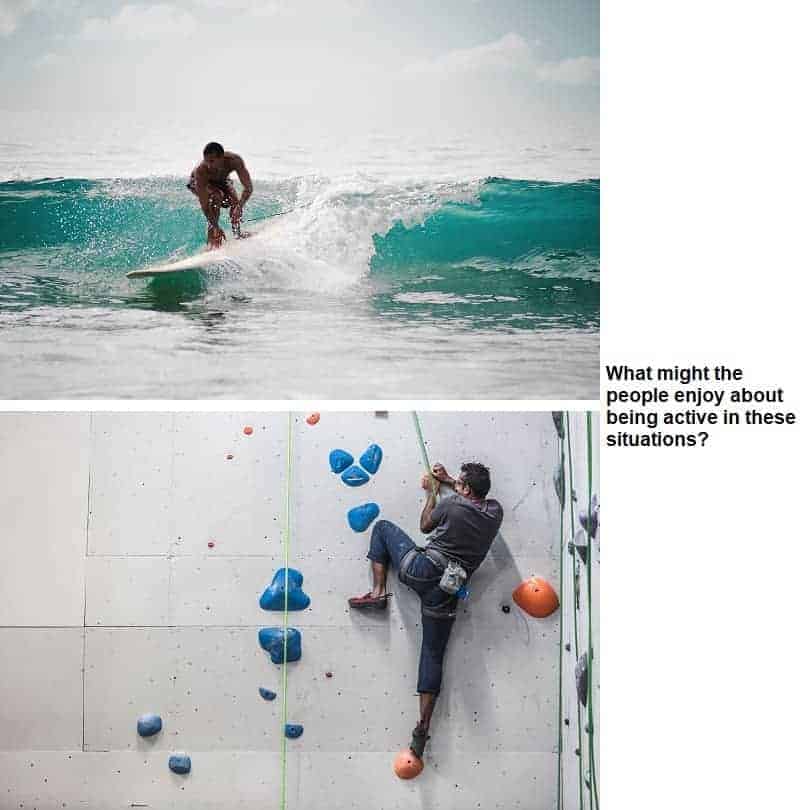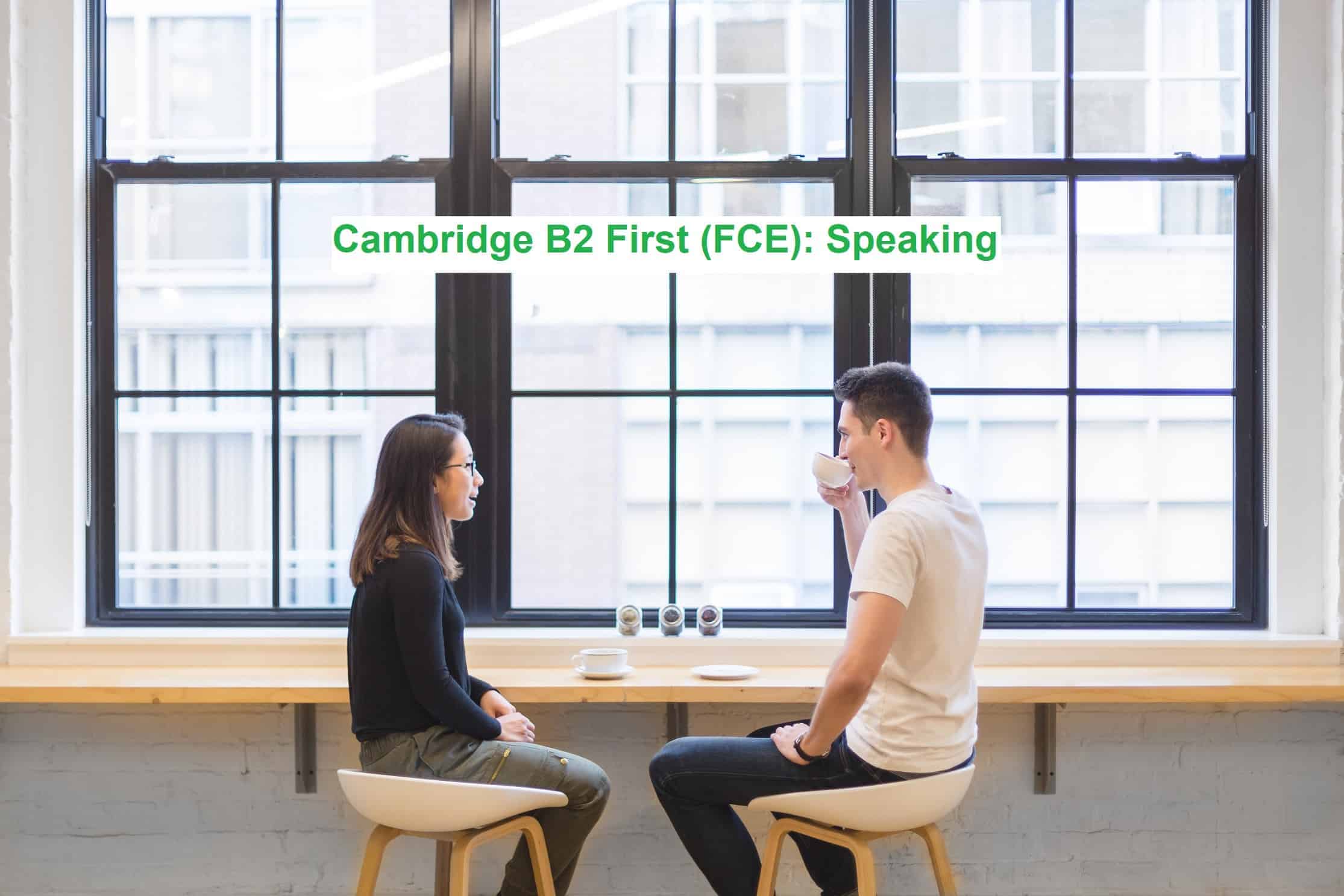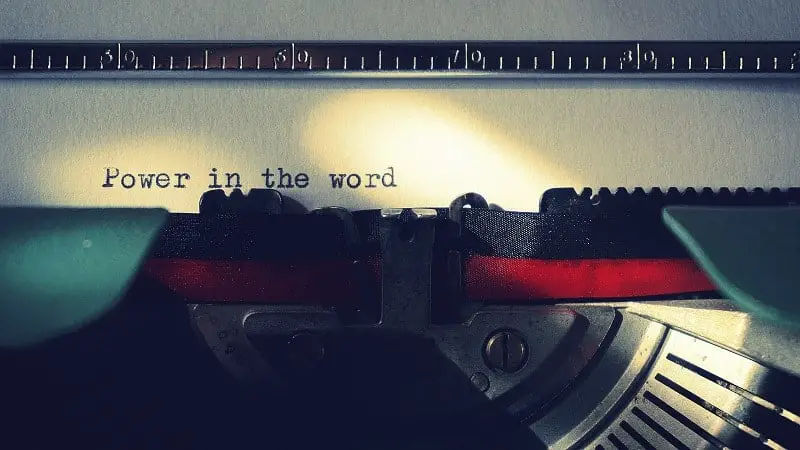Cambridge B2 First Speaking in a nutshell
Speaking is one of the five exam papers in Cambridge B2 First, the others being Reading, Use of English, Listening and Writing. It usually takes around 14 minutes and you are tested together with another candidate.
In the Speaking test, you need to demonstrate your ability to respond to simple and more complex questions, as well as discuss and negotiate different topics with a partner.
There are four parts in the Cambridge B2 First Speaking test:
- A conversation between the interlocutor (examiner) and each candidate. The examiner asks questions about the candidates preferences, hobbies, likes/dislikes and other personal topics.
- An individual ‘long turn’ by each candidate. The examiner gives you two photographs and a question to answer. You also need to answer a question about the other candidate’s photos.
- A discussion and decision-making task in which the examiner gives you and your partner a scenario plus written prompts for you to talk about.
- A discussion of different questions with your partner based on the topic in Part 3.
There are always two examiners in the room. One of them asks all the questions and times the exam while the other person takes notes and marks your speaking. The main marking criteria are your ability to form full and informative answers, your use of grammar and vocabulary, pronunciation, and the interaction between you and your partner.
Speaking accounts for 20% of your overall mark in B2 First.
The different parts of B2 First Speaking
In this part we are going to have a look at the different sections of the Speaking test. You are going to learn what area of your speaking is tested in each part, we are going to have a look at an example and I’m going to give to some useful tips so you know exactly what to do and how to get great marks.
Speaking Part 1
Part 1 of the Speaking test is a little bit like a warm up for you and your speaking. The examiner asks you some questions about yourself and your life, which could include your family, friends, hobbies, plans, experiences and other topics.
This part only takes around 2 minutes and you need to show your ability to use social and interactional English.
There is a rule that I always teach my students and it has helped many of them: Always support your answers and try to speak for 20-25 seconds per answer.
Many candidates, especially the unprepared ones, go into the exam and give very short answers to the pretty short questions the examiner might ask them, for example:
Examiner: Where are you from?
Candidate: From Spain.
The answer in this case is completely unsupported and, therefore, too short. Instead, the candidate could have given more information by detailing where she is from.
Examiner: Where are you from?
Candidate: I’m from Barcelona, the second-largest city in Spain. It is the capital of the province of Catalonia and located right on the Mediterranean coast. The climate is hot in summer and not too cold in winter so many tourists come to visit and explore it. Barcelona is also famous for its architecture mainly because of Antoni Gaudi and his Sagrada Familia.
This is a lot better. There are much more details so the examiner is fully informed.
Remember, reasons, examples and details give you the extra information you need so don’t forget about them.
Speaking Part 2
In Part 2, you need to speak on your own about a pair of photographs for about a minute. You compare and contrast the two pictures and answer a written question about them. In addition, you answer a short question about your partner’s photos (30 seconds).
The total time for both candidates is usually around 4 minutes. You need to demonstrate that you can speak spontaneously and for an extended period of time (one minute) with the focus on comparing and describing as well as giving your opinion.
The two most important aspects of this task are your time management and your choice of language. As I said earlier, you are expected to compare/contrast and answer a question about the pictures the examiner shows you. Spend about equal time on these two parts and use some specific language in your response. Here’s an example:

In both photos, the people seem to be very focussed because the man at the top has a very intense look and body language while the man in the second photo looks as if he is in tricky situation climbing a wall with only few holds. There is also an element of danger to both situations even though the men move in different environments.
This kind of danger is perhaps the reason why they enjoy their sports. I have watched videos in which surfers get wiped out by big waves and it appears to me that that is actually part of the fun. I also think that the climber enjoys the challenge of combining strength and flexibility to get to the top of the wall and I can imagine that it must feel great to achieve this kind of goal. On top of that, climbing can also be practised in the outdoors and, just like surfing, it brings people closer to nature. For me, that would also be a reason to do these types of sport.
This is probably worth one minute of speaking. I’ve highlighted all the useful language for you so you get a better idea of how to deal with Speaking Part 2.
If you want more information about this part of the Speaking test, I wrote a very detailed article with another example, analyses of two recorded Part 2s as well as tons of useful language. You can follow the link below to find out more.
>>> A detailed analysis of Speaking Part 2 with many useful tips and tricks <<<
>>> If you want a FREE grammar and spelling correction tool, click here! <<<
Speaking Part 3
Part 3 is where you and your partner have to work together. The examiner gives you a situation, some written prompts and a question for you to discuss in about two minutes. Once you finish that discussion you need to make a decision together based on the examiner’s instructions in another minute.
Overall, this part of the Speaking test takes about four minutes and the language focus is definitely on interacting with your partner (agreeing/disagreeing, giving your opinion, discussing topics, negotiating, reaching a decision together, etc.).
As with the other parts, there is a lot of useful language that you can and should incorporate into your practice, but because of the crazy amount of expressions and other tips that I would like to share with you I wrote an article just about Speaking Part 3. Simply follow the link below and find out everything you need to know including strategies and all the language that gets you to great marks.
>>> Everything you need to know about Speaking Part 3 <<<
Speaking Part 4
In the last part of the Speaking paper in Cambridge B2 First you discuss different questions with your partner. The topic is always the same as in part 3, but they are not written down. Instead, the examiner only asks them verbally and you have to deal with it on the spot.
This part takes around four minutes and the examiner just keeps asking questions until the time is up. Here, you should focus on giving your opinion, agreeing and disagreeing with you partner as well as speculating about the questions.
I can refer you back to my article about Speaking Part 3 as there is a lot of overlap when it comes to useful expressions. However, there is no time limit for each question so you are freer in your responses. This also means that you need to measure yourself in order not to dominate the conversation too much and outshine your partner.
Be smart and do the right thing.
Time to practise
With all the information in this article I hope you have a better understanding of how the Speaking paper in Cambridge B2 First works, but now it is time to put your knowledge to work. Find a partner you can practise with and keep checking put the many great videos online so you can steadily improve and learn from your mistakes.
Practice makes perfect!
Lots of love,
Teacher Phill 🙂







